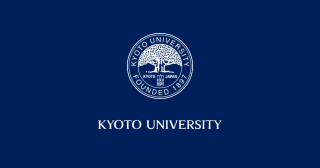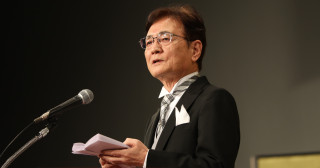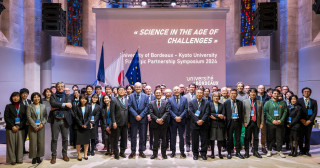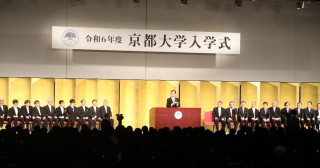The Symposium on Connectivity of Hills, Humans, and Oceans: Local Initiatives to Nurture the Human-Nature Connection -- Corporate Efforts in the Land of a "Freshwater Sea" took place mid-December at Campus Plaza Kyoto.
The event was centered on case reports about business initiatives in environmental management and regional development underway in Shiga Prefecture, which is home to Lake Biwa and known as one of the greenest prefectures in Japan.
The program began with a keynote speech by Ms Yukiko Kada, ex-governor of Shiga, who shared her experiences of the environment and people of the towns surrounding the largest lake in Japan, detailing her thoughts and actions as a lawmaker and researcher working to serve surrounding communities. Reflecting her profound understanding of and interest in societal-environmental interactions, her talk delved into concepts such as environmental symbiosis, living environmentalism, and fureai kachi , literally "interaction values", referring to the capability of some facilities and locations to facilitate interpersonal interactions.
Case studies were presented by three members of Shiga's business community: Mr Kazuyuki Sanuki, manager of an organic vegetable farm owned by confectionery maker Taneya Co Ltd, Mr Kenichi Maeda, president of stationery manufacturer Kokuyo Product Shiga Co Ltd, and Mr Katsunori Tatsumi, head of corporate social responsibility (CSR) at The Shiga Bank Ltd.
Mr Sanuki started by outlining his company's forest and sato (village forest) creation project whose goal is to build a "'confectionery forest' that serves as a gathering place for all people" across an area of land large enough to accommodate three baseball fields. Next, Mr Maeda recounted the efforts involved in developing, manufacturing, and marketing a line of stationery products, named ReEDEN, that are made with reed harvested from Lake Biwa and its tributary rivers, further reporting on a reed-grove maintenance program that had been begun by just a few volunteers but is now supported by a growing number of participants. Finally, Mr Tatsumi presented on his bank's "environmental rating" system aimed at promoting corporate sustainability efforts, and an environmental communication program designed to facilitate stakeholder dialogue.
Those initiatives were then discussed from the perspective of hill-human-ocean connectivity, in lectures delivered by three Kyoto University researchers: "Environmental Governance and Regional Development" by Program-Specific Associate Professor Miki Yoshizumi from the Educational Unit for Studies on Connectivity of Hills, Humans and Oceans (CoHHO), "Corporate Activities and the Environment" by Associate Professor Akira Yoshino from the Graduate School of Global Environmental Studies (GSGES), and "Forest and Satoyama Environments" by Professor Shozo Shibata, also from the GSGES.
These lectures were followed by a panel discussion on "Developing Products, Human Resources, and Communities by Leveraging the Connectivity of Hills, Humans, and Oceans", held with Program-Specific Associate Professor Natsuki Shimizu from the Educational Unit for Studies on CoHHO serving as the coordinator. Some of the topics discussed by the panel include Shiga's religious and cultural heritage as an additional factor -- in addition to Lake Biwa -- behind the strong sense of community shared by local residents, and steps needed to ensure the continuation of corporate sustainability efforts and network building with local partners. Ms Kada, meanwhile, argued that researchers and academics should not shy away from politics, and conveyed her hope that more women would enter and remain in the workforce and contribute their unique perspectives to society.
Despite taking place during the traditionally busiest time of year in Japan, the four-hour event drew more than 150 attendees, many of whom expressed satisfaction afterwards at the opportunity to listen to inspirational and informative talks about the topics covered.

From left: Ms Kada, Mr Maeda, Mr Sanuki, and Mr Tatsumi

Panel discussion

Another view of the panel discussion





